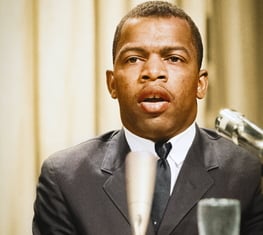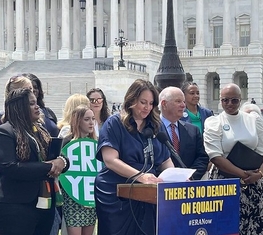DEI Success Stories: Land Acknowledgements
LWVUS has included land acknowledgements in its most recent national Council and Convention events and encourages Leagues to do the same as all of us are on Native land. We spoke to two Leagues, LWV of Lansing Area (MI) and LWV of Seattle-King County (WA) about how they are honoring our Native lands by opening events and gatherings with the acknowledgement of the traditional inhabitants.
LWVUS has included land acknowledgements in its most recent national Council and Convention events and encourages Leagues to do the same as all of us are on Native land. We spoke to two Leagues, LWV of Lansing Area (MI) and LWV of Seattle-King County (WA) about how they are honoring our Native lands by opening events and gatherings with the acknowledgement of the traditional inhabitants.
Question: Why is acknowledgement important?
Acknowledgement may seem like a small gesture but it becomes meaningful when combined with informed action. It is a simple yet powerful way to show respect by correcting the stories and practices that erase indigenous culture and historical truth. LWV has used the land acknowledgement resources provided by USDAC which offer these as beneficial reasons for this practice:
-
Recognition and respect.
-
Counter the “doctrine of discovery” with the true story of the people who were already here.
-
Create a broader public awareness of the history that has led to this moment.
-
Begin to repair relationships with Native communities and with the land.
-
Support larger truth-telling and reconciliation efforts.
-
Remind people that colonization is an ongoing process, with Native lands still occupied due to deceptive and broken treaties and practices of eminent domain and other mechanisms intended to benefit government or corporate America.
-
Take a cue from Indigenous protocols, opening up spaces with reverence and respect.
-
Inspire ongoing action and relationships.
It also offers these important disclaimers:
-
It is not simple
-
There are many ways to acknowledge
-
This practice of acknowledgement is not new
-
Acknowledgement is only the first step not the final solution
ACTION: Identify
If we want to acknowledge the Native inhabitants of our lands, it is our responsibility to make sure we know who these inhabitants are. The LWV of Lansing Area in Michigan has worked to acknowledge the Chippewas around Jackson, Michigan and members such as Donna Mullins, the current President of the League, have visited tribes regularly at the quarterly. Mullins first developed the idea for land acknowledgements after going to Ontario and watching plays that had land acknowledgements.
Likewise, the LWV of Seattle King County, Washington explains how their effort towards providing land acknowledgements are commonplace in Washington. When speaking to the League president, Heather Kelly, she said that before most public meetings, nonprofits provide a detailed land acknowledgement specific to the region the recipients are from are occupying. Some of the tribes the League acknowledges are the Duwamish and Coastal Salish tribes.
Here are some places you can look online:
-
Wikipedia entries on many cities document some history of Indigenous inhabitation. Be sure to cross- check what you find there with other sources.
-
This map of Native Land is one of the more comprehensive maps available: https://native-land.ca/
-
The Native Languages site offers breakdown by state, with contact information for local tribes: http://www.native-languages.org/
ACTION: Articulate
There are many different ways to formulate the statement of acknowledgement that you will share at public gatherings. The LWV of Lansing Area in Michigan was inspired by Michigan State University’s land acknowledgement. They worked to change this acknowledgement to apply to their area. Mullins states: “listen and be relevant to groups that are not heard as well as they ought to be, we need to do the right thing, it can’t be about us it just can’t be about us.”
An Acknowledgement could look like any of the following:
- “We acknowledge that we are on the traditional land of the _________ People.”
- “I would like to acknowledge that this meeting is being held on the traditional lands of the _______ People, and pay my respect to elders both past and present.”
- “I want to respectfully acknowledge the ________ People, who have stewarded this land throughout the generations.”
- “We would like to begin by acknowledging that the land on which we gather is the occupied/unceded/ seized territory of the _______ People.”
- “I would like to begin by acknowledging that we are in _____, the ancestral and unceded territory of the ________ People. "
The LWV of Seattle King County, Washington has evolved its acknowledgement over the years to move from a more colloquial lingo to a more formal acknowledgement. They are working to make the acknowledgement less of a recitation and more of an opportunity to be mindful and engage members of the League. They have also been working to pair the acknowledgement with an action step to show allyship and not just performative allyship. Some actions of next steps they have suggested are:
-
Using the website Real Rent to pay rent to certain tribes.
-
Education items: suggested resources, places to visit to learn more about tribal roots
-
Connect people with resources the tribe recommends to learn about their culture and heritage.
-
Legislation eliminating barriers for Native people to have more access to resources such as fishing rights for the tribe (write Senators and Representatives)
ACTION: Deliver
Once a League has identified who to name and has come up with a statement, they must incorporate and deliver it in public gatherings. Starting this year, the LWV of Lansing Area in Michigan incorporated their acknowledgement into every presentation they delivered to their community. Mullins states: “as an organization, when we say we want to work on this then I have to demonstrate it, then we have to demonstrate it… whatever you do it needs to be intentional.”
The LWV of Seattle-King County, Washington has incorporated their land acknowledgement into all big forums and annual meetings to educate their members as well as provide recommended action steps.
Recommendation: For Other Leagues
Land acknowledgements can be awkward but Donna Mullins suggests to not be afraid of awkwardness. “If you are intentional, people forgive the awkwardness easily. Just do the work,” says Mullins. The practice of cultural humility is important---being humble when addressing the viewpoint of someone who is not an expert about other cultures and experiences. It is important to approach land acknowledgments and native cultures with a humble understanding that you are not an expert in someone else’s culture. Heather Kelly suggests that Leagues follow these steps and also check the tribes’ websites to read up on the history and take real action rather than being simply performative.
Recommendation: Identify the tribes in your area and read up on their history with special attention paid to tribal resources.
Related Content
Understanding and Partnering With Native American Communities
July 23, 2020
This covered partnering with Native American communities. It included brief background on how to learn more about Native American history, building relationships with Native American communities, and Native American voting rights.
Event Planning Through a DEI Lens
February 18, 2021
This webinar offered tips on virtual event planning with a focus on applying a DEI lens to planning.




